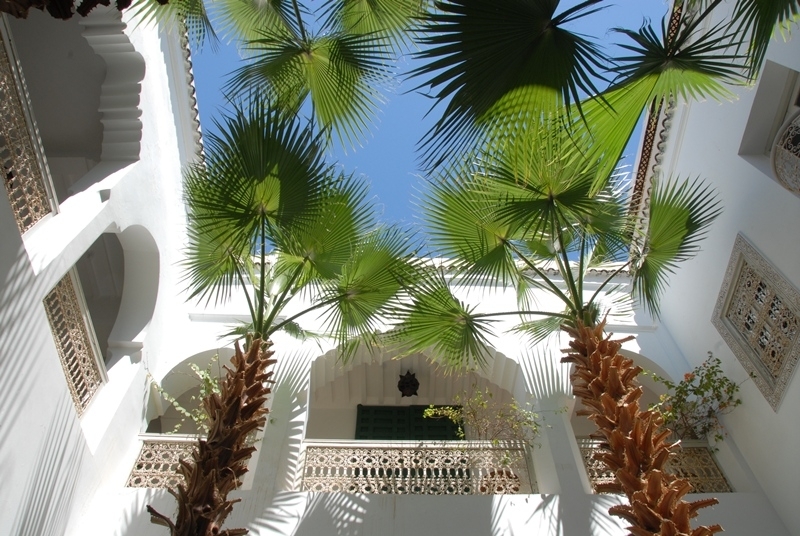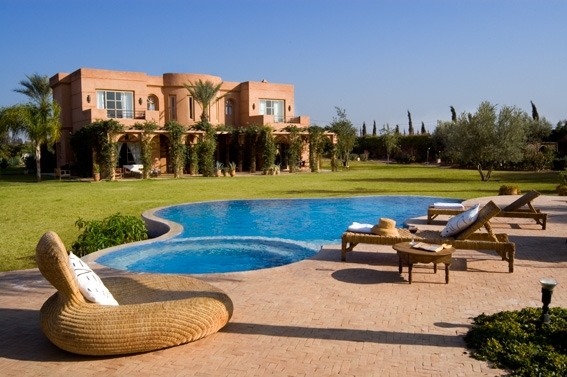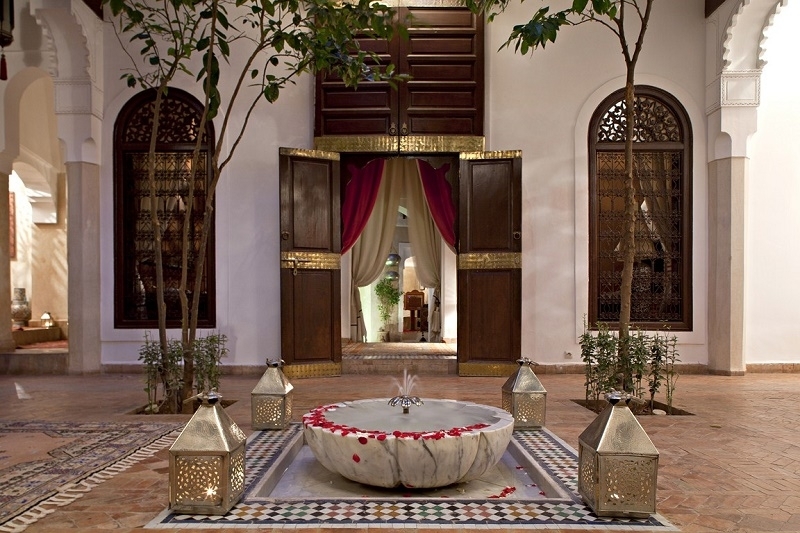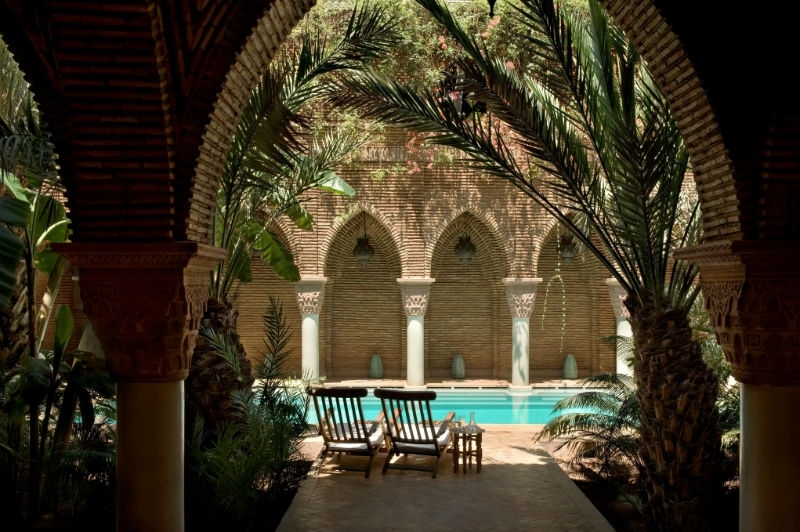The Bahia Palace, Marrakech
December 14th, 2014
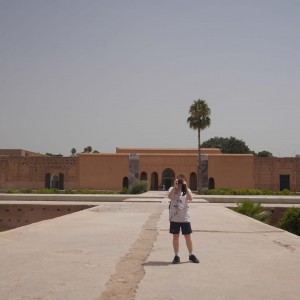
Located along Rue Bahia Bab in the Mellah district of the Marrakech Medina is the Bahia Palace, a stunning set of tranquil gardens enclosed within the beautifully decorated walled pavilions.
Bou Ahmed, a former slave who rose to a position of power under sultans Moulay Hassam and Abd Aziz, built the palace in the last years of the 19th century in an attempt to outshine any other building in Marrakech. One could argue that this project was a success. Indeed, the Bahia Palace, meaning ‘brilliance, certainly lives up to it’s name: sunlight shines through the wrought-iron windows casting beautiful shadows on the traditional Zellij tiles, while, in the courtyard, fresh orange trees and shaded gardens surround a trickling fountain.
Legend has it that Bou Ahmed was so unpopular that upon his death his palace was looted and his possessions stolen. Although they were briefly used during French occupation, the palace’s cavernous rooms still lie practically empty today, accentuating the beauty of the architecture and space.
The Bahia Palace offers both a serene oasis in the heart of the Medina and a fascinating glimpse into the history of the kingdom of Morocco, all just a short walk from the Jemaa el-Fna square. A definite must visit.
Location: Rue Bahia Bab Mellah
Opening times: Open every day except Friday, 8h00 to 18h000
Entrance fee: 10dh
Tags: bahia kasbah, Bahia Palace, Marrakech, marrakech museum, museum marrakesh, The Bahia Palace, things to do in marrakech, things to see marrakech
Posted in Cultural & Geographical, Marrakech, Marrakech Tourist Attractions | Comments Off on The Bahia Palace, Marrakech
Dar Si Said Museum, Marrakech
December 7th, 2014
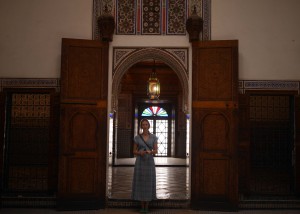
Dar Si Said was originally a mansion built by Sidi Said, royal Visir and half-brother of Ba Ahmed Ben Moussa (the former slave who built the nearby Bahia Palace), in the nineteenth century. Today, the interconnecting courtyards and beautiful wooden ceilings house the Museum of Moroccan Arts and Crafts: a collection of carpets, jewellery, weaponry, pottery and textiles from Marrakech, the Atlas Mountains and across Morocco.
Our personal highlights include the domed ceiling in the reception room made from carved cedar and, primitive four-seater wooden Ferris wheel of the type found in ‘moussems’ (country fairs) around Morocco.
Location: Ri
ad Zitoun el Jadid
Opening times: Open every day except Tuesday from 9h00 to 12h15 and from 15h00 to 18h15
Entrance fee: Adult 20dh / Children under 12 5dh
Tags: culture marrakech, dar sis said, Moroccan design, Moroccan history, museum marrakech, museum marrakesh, things to do marrakech, things to see marrakech
Posted in Cultural & Geographical, Marrakech, Marrakech Tourist Attractions | Comments Off on Dar Si Said Museum, Marrakech
Tiswin Museum, Marrakech
December 1st, 2014
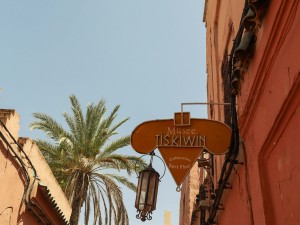
The Tiskiwin Museum was founded Bert Flint – a Dutch anthropologist who himself has been a Marrakech resident since 1957– to display highlights from his personal collection of Amzigh Berber artefacts. Such is the importance of Flint’s collection that Tiskiwin is now part of the Marrakech University Cadi Ayyad.
The stunning collection includes Berber tents, carpets, fabrics, basketwork, art and the minutiae of everyday life and is ingenuously displayed as a journey along ancient Saharan trade routes from Marrakech to Timbuktu and back. On arrival visitors are offered a comprehensive guide sheet, available in several languages, in order to decode the hidden significance of the ancient and historic objects.
Amazingly 90% of the museum’s artefacts were purchased in the world famous Souks of Marrakech, which remain to this day a treasure trove of surprises reflecting the diversity and wealth of North African culture.
The Museum is truly a hidden gem, not to be missed!
Location: 8 Rue de la Bahia
Opening times: Open daily, 9h30 to 12h30 and from 15h00 to 18h00
Entrance fee: 15dh
Tags: anthropology, Berber, Marrakech culture, moroccan culture, museum marrakech, museums in marrakesh, things to do in marrakech, tiskwin, tiskwin museum
Posted in Cultural & Geographical, Marrakech, Marrakech Tourist Attractions | Comments Off on Tiswin Museum, Marrakech
The Moroccan Leather Poof
November 24th, 2014
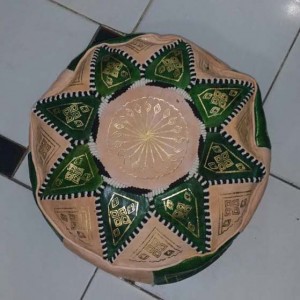
In Marrakech you will see a lot of objects that hold a certain special place in Marrakechi’s hearts: there is the motorbike, the favourite tool for many locals to get around the city; the tagine pot, the implement responsible for making the country’s traditional, staple dish and the poof. The poof is a Moroccan leather chair in the shape of a circular pocket; it is often bought empty and filled later at home with rags or old material. The leather ranges in quality from quality Camel or goat leather – preferred due to it’s thickness and subsequent strength – through to the cheaper cow hide.
Whilst walking around the narrow streets of the Medina, it is easy to assume that the poof is simply a decorative item for tourists, an easy souvenir to bring home. However it is behind closed doors that the poof is most celebrated item of furniture; indeed, most households use them!! A Moroccan friend once told me that the poof is better than any other chair for too reasons: it provides beautiful and unique decoration for the house, and it also better for your back than sitting on a wooden chair. Although we are not sure if this second reason holds any scientific fact, here at Hip Marrakech we can confirm that the poof is very comfortable!
Tags: arabic style, foot stool, interior design morocco, leather poof, Moroccan design, moroccan futon, moroccan interior design, moroccan poof, the poof
Posted in Cultural & Geographical | Comments Off on The Moroccan Leather Poof
The Tagine Pot
November 17th, 2014
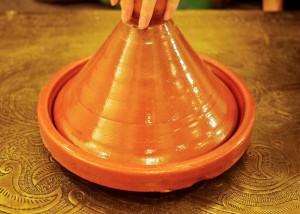
The Tagine (or Tajine) is perhaps the most popular dish in Morocco. It can be found literally everywhere, from the roadside café to the luxury restaurant, and remains a staple meal for both tourists and locals alike.
The slow-cooked savoury stew is typically made with sliced meat, poultry, or fish together with vegetables – although many carnivorous travellers have confessed that they prefer the Vegetable Tagine to it’s meat-based brother. The dish is actually named after the term for the two-part terracotta dish in which it is cooked, the Tagine pot. The flat base holds the ingredients and spices whilst the dome or cone shaped lid is designed to hold in the condensation to produce succulent meat, steamed vegetables all held in a wonderful sauce.
Indeed, the Tagine dish proves so popular that many tourists are often desperate to find space in their bag to fit a Tagine pot so that they can replicate the dish at home.
In many ways the Tagine epitomizes the Moroccan cusine: it is spicy, healthy and designed to be shared by many. So why not bring home a Tagine pot to share the magic of Marrakech with your friends and family? That is, if you can fit one in your bag!
Tags: Marrakech, moroccan tagine, moroccan tajine, moroccan tajine pot, tagine, tagine marrakech, tagine pot, tajine, tajine pot, terracotta tagine pot
Posted in Cultural & Geographical, Marrakech, Photo a day | Comments Off on The Tagine Pot
The Mystery of the Hanging thread
November 10th, 2014
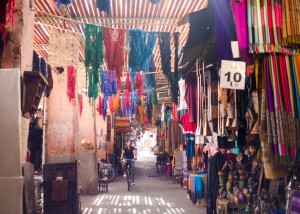
Although Marrakech is often known as ‘The Red City’ thanks to the pisé-cement ramparts that surround the old town, once you enter the Medina it becomes clear that Marrakech actually holds a multitude of bright and vibrant colours. We noticed at this point in the ‘Needle and Thread’ Medina walk, as you turn south towards the Jemaa el-Fna Square, there are rows of brightly coloured thread hanging down from the rafters of the Souks, casting beautiful abstract shadows on the Souks’ floor.
We were intrigued by the mystery of the hanging thread and asked a local stall-holder, an elderly man selling similarly colourful pashminas, what it was there for. He was unsure and gestured for us to follow him over to a small table where two of his friends were playing cards and drinking café au lait. The first man suggested that the colourful thread was hung here to dry from the nearby ‘teinturerie’ (dying house). The second man, however, disagreed. He claimed that he had never seen wet wool being hung up and that the thread was spare wool used as a form of shade to keep the area as cool as possible. Our conversation continued for a few minutes and the three local Marrakchis carried on debating after we said our goodbyes.
Alas, the mystery of the colourful hanging thread was not solved and we are still unsure what to make of the rainbow of dangling thread. But this uncertainty only adds to the mysterious magic of Marrakech; perhaps you can solve this mystery yourself whilst on our ‘Needle and Thread’ walk by downloading our free Hip Marrakech app?
Tags: marrakech craftwork, Marrakech souks, marrakech travel, marrakech travel guide, marrakesh souk, medina souk, medina souks, souk, souks, things to do in marrakech, things to do in marrakesh, visit marrakech
Posted in Cultural & Geographical, Marrakech Tourist Attractions, Photo a day | Comments Off on The Mystery of the Hanging thread
Berber Museum, Marjourelle Gardens
October 12th, 2014
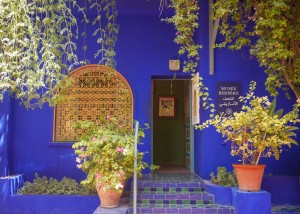
The Berber people are the ethnicity indigenous to North Africa, known for their fine craftwork, delicious cuisine and traditional music. The newly refurbished Berber museum, situated within the Majourelle Garden, is a fantastic resource cataloguing Berber life from diverse regions of Morocco.
The exhibits document all aspects of Berber life, from craftwork to clothing and jewellery to carpets. All objects are beautifully displayed and perfectly lit; we especially enjoyed the Jewellery room with a ceiling that mimics the night sky. Maps and explanatory texts are available in French, English and Arabic, and photographs, archive films and audio-visual documents are specifically curated for the visitors throughout their journey.
This small museum is a definite favourite of ours, a ‘must-see’ on any visit to Marrakech. The Berber Museum is located within the Majorelle Gardens in the Marrakech New town of Guiliez. Tickets for the museum can only be purchased alongside the entry fee to the gardens themselves, an attraction we also highly recommend.
Tags: beber museum majourelle gardens, Berber, Berber culture, berber museum, majourelle gardens, majourelle jardin, marjourelle blue
Posted in Marrakech, Marrakech Tourist Attractions, Photo a day | Comments Off on Berber Museum, Marjourelle Gardens
Choukara: from Shepherds bag to fashionable leather purse
October 5th, 2014
I
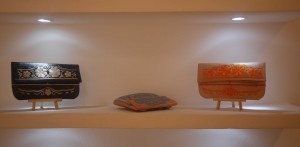
n the Marrakech Medina there are many shops selling a variety of leather bags ranging from massive travel bags to day s
atchels to small leather purses. Despite the plethora of bags on sale, the traditional Moroccan Choukara is a bag which has eluded many Marrakechi stallholders. Traditionally made from Goat leather, the Choukara is a small Moroccan purse-like bag, traditionally used by shepherds and workers to carry their lunch during the working day. In this way, as these outside jobs were considered to be ‘men’s jobs’, the leather Choukara is traditionally a bag for men; however, due the embroidery design and purse-like nature of the bag, the bag is finding a renewed popularity with the female gender.
The Choukara is difficult to find in the Souks, however at Hip Marrakech we have found a great example of the bag at the Baboucheshop flagship store in the Souk Cherifa area. You can find directions to the shop on our Hip Marrakech app, available to download for free from the Appstore. The Baboucheshop also lies on the ‘Leather and Tanning’ Medina walk; an app-based walk that takes you across the city highlighting cultural sites of interest focused around the traditional leather industries of Marrakech.
Tags: baboucheshop, bohemian leather bag, bohemian style fashion, boho fashion, Choukara, fashion shop marrakech, leather marrakech, marrakech fashion, souk cherifa, unique boutique marrakech
Posted in Cultural & Geographical, Marrakech, Photo a day | Comments Off on Choukara: from Shepherds bag to fashionable leather purse
Vegetarian Travel Guide in Marrakech
September 28th, 2014
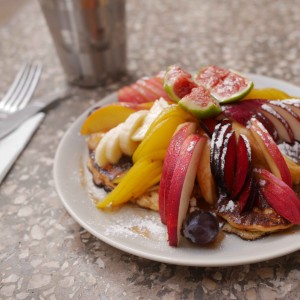
As I have been vegetarian for over 14 years, I know how difficult it can be to source vegetarian options on menus in England, let alone whilst travelling on holiday.Here is our guide to Vegetarian travel in Marrakech.
For many Moroccans, especially those who live more rural areas, vegetarian cuisine often means taking the meat off the Cous cous or Tajine or expertly eating around the meat. However, if you order a vegetarian meal at a café or restaurant in Marrakech then this is definitely something you don’t have to worry about. As meat is an expensive luxury for most locals, there is no risk of ordering what looks like a vegetarian dish and finding a big chunk of meat hidden amongst the fresh vegetables. Getting exactly what you order is perhaps the most basic thing one can expect when dining out, but this is a great place to start when avoiding certain food.
When it comes to Moroccan cuisine, there is in fact a wide selection of vegetarian choices. (Indeed, as a predominantly Muslim country pig is already off the menu.) Every single café, restaurant and street-food stall has an excellent range of salads ranging from the standard Moroccan Salad – made from tomato, cucumber, onion and fresh herbs – to more adventurous salads including aubergine (eggplant), olives and a range of fresh vegetables. Another menu-staple is 5-vegetable cous cous and, a personal favorite of mine, the Vegetable Tajine. Many carnivorous tourists and travellers have in fact revealed to me that they prefer the Veggie-Tajine to its meat-based brother.
If you are looking for some less traditional Vegetarian cooking, then my top recommendation is Earth Café. Located just 5 minutes away from Jemaa el-Fna, very close to Dar Habiba, Earth Café is the only exclusively vegetarian restaurant in Marrakech. All the food on the imaginative menu is grown on the Earth café farm, just outside Marrakech. It is even possible arrange to visit the farm where they also offer cooking classes.
Ultimately, although the concept of being vegan, vegetarian or even preferring not to eat meat is an alien concept for most Moroccans, they are very accommodating . Where they will ask a lot of questions about your eating habits – a process that is pretty much the standard response all around the world – you will never feel judged. Therefore, although Marrakech and Morocco doesn’t exactly make it onto the list of ‘top vegetarian travel destinations’, it is a place that you can visit without worrying about going hungry and you will find some delicious surprises.
Tags: earth cafe marrakech, vegan food marrakech, vegetable cous cous, vegetable tajine, vegetarian cuisine, vegetarian restaurant marrakech, vegetarian travel
Posted in Marrakech, Photo a day, Restaurants and Food | Comments Off on Vegetarian Travel Guide in Marrakech
Symbolism of the Tanning process in the Marrakech Tanneries
September 14th, 2014
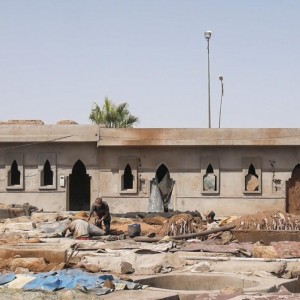
The Marrakech Tanneries are perhaps one of the must-see attractions in red city. The traditional tanning process, as witnessed in the Marrakech tanneries, is laced with symbolism. It is often said that the position of the tanneries itself, the east of the Marrakech Medina, symbolizes the rebirth of animal skin into leather through the sun rising to the east. Indeed, the complete process of tanning skins itself is also deeply symbolic: according to tanners, this first step of the tanning process, where the skins are fermented in a solution for a 3-6 days, is where the skin eats, drinks and sleeps before being ‘reborn’ from the water. When the skin is treated with a pigeon poo solution, it is said to receive nafs, a spirit that begins the process of rebirth and renewal. Finally, it is in the final stage of the tanning process, where the hide is stretched and smoothed over coarse ropes, that the skin is reborn into leather.
Here at Hip Marrakech, we strongly advice you visit the Marrakech Tanneries during your visit to the red city so you can witness the unique, traditional process with your own eyes. If you are interested in the traditional leather craft industry, you can follow our ‘Leather and Tanning’ Medina walk, accessible for free via the Hip Marrakech App.
Tags: camel leather, cow leather, goat leather, how leather is tanned, how to make leather, leather tannieries, Marrakech tanneries, myths leather, myths marrakech, sheep leather, symbolism in tanning process, tanning leather, traditional leather tanning process
Posted in Cultural & Geographical, Marrakech, Marrakech Tourist Attractions | Comments Off on Symbolism of the Tanning process in the Marrakech Tanneries

